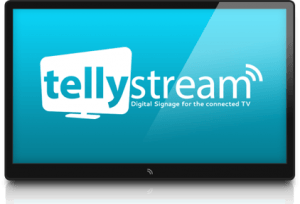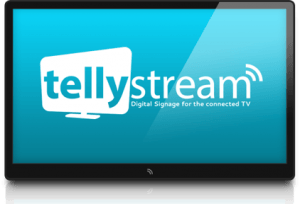
Mash-up From Oslo Uses XBMC And Raspberry Pi To Make Digital Signage
December 12, 2013 by Dave Haynes
 Norwegian start-up Tellystream has released a digital signage platform aimed squarely at the vast market of small business end-users who don’t have much enthusiasm for recurring monthly fees or what, in their general view, are unnecessarily expensive displays and playback devices.
Norwegian start-up Tellystream has released a digital signage platform aimed squarely at the vast market of small business end-users who don’t have much enthusiasm for recurring monthly fees or what, in their general view, are unnecessarily expensive displays and playback devices.
This system works on Samsung Smart TVs (the consumer versions, not Samsung’s Smart Signage commercial display line) and low-cost devices like the Raspberry Pi. Cost is a one-time license of $129.
Says a news release:
With Tellystream, companies can benefit from the advantages of an info screen or digital signage solution at a fraction of the cost of a traditional system. The software interfaces directly with Samsung consumer TVs over a local network needing no additional hardware. This makes setting up a digital signage system as simple as setting up a home TV. In addition these screens are stylish, inexpensive and have wireless networking built-in.
Designed for companies, schools, universities, pubs, sports venues, shops and many more, Tellystream allows customers to reach their target audience with the right content in near real-time – at a very low cost and with no technical expertise required.
“Tellystream set out to make digital signage simple and fun. In many situations it is difficult to judge what the ROI (return on investment) for a digital signage project will be. Therefore we decided to make the investment truly negligible resulting in a positive return even for the most limited use case,” explained Co-Founder Carsten Lehbrink.
The software uses a simple touch-enabled user interface to build content streams from images and web pages. It also supports transition effects. Web pages will update in near real-time making it ideal for displaying information with web technologies. Content is easily created from corporate Powerpoint® or Keynote® templates that are read as images.
“All studies show that employee satisfaction rises significantly with good internal communication. Tellystream is a simple and inexpensive building block in any effective internal communication strategy handling anything from HSE or employee communication to visualization of company metrics,” Co-Founder Guido Seifert points out.
Here’s what’s going on with it …
In a nutshell, you install software on a spare Windows PC with decent horsepower and graphics capabilty, and use that to build your programming and stream it to a media playback device – even a Raspberry Pi – running XBMC, the free, open source software media player and entertainment hub that has a huge user base.
There is a client and a server aspect to the software service, though they both tend to run on the same Windows machine that will get used to push out the content stream. It will work on Windows 8 units if the user wants to manage things with a touch screen.
Users can, if they want, have the server on a different machine and access it via the client machine User Interface, though they need to be on the same local area network.
The server has a rendering engine for web pages, a transition engine, a streaming server and a video encoder to encode the stream into what Tellystream says are low bandwidth, high quality video.
To keep the load on the machine down it is not continuously encoded video but segments assembled together. This means, says Tellystream, that if nothing changes they are re-used and there is no encoding need, which leaves the CPU load very low.
The start-up, based in Oslo, has a few videos, including this demo showing how programming can be put together.
As you can see this is pretty low-end stuff best suited to JPEGs and presentation slides. The demo does not go much into video, which would be supported but is not likely what a lot of small businesses would do.
Is it disruptive? A little bit, I suppose.
You have very well-established companies like Rise Vision offering avery robust and very free Web-based CMS, with a developer community getting it working on all kinds of devices, including Raspberry Pis. There are also companies with fee-based SaaS licensing that dips down below the $10/month range. And display companies like Philips have a smart TV-streaming thing I saw at InfoComm. Then there are all those Android device offers out there now.
I suppose you could argue that something like Apple’s AirPlay and other services like it do the same sort of thing, though you’d still need the CNS at the front end.
This is a little disruptive in terms of pricing and in the use of XBMC. It looks well thought-through, and the initial marketing with explanatory videos, marketing videos, FAQs and a decent website, is leaps and bounds ahead of many start-ups (and also many established software companies) in the sector.
One to watch.



Leave a comment